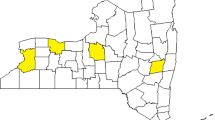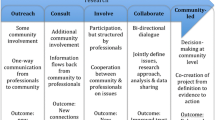Abstract
We study the question of environmental equity via generalized linear modeling for the metropolitan New York City region and ask whether, after accounting for socioeconomic status, particular racial/ethnic populations bear a disproportionate burden of hosting environmentally undesirable sites. Our data consist of population demographics for 2216 census tracts linked to 354 environmentally undesirable facilities, including toxic release inventory sites, hazardous waste treatment, storage, and disposal facilities, and other common urban problem sites such as landfills, incinerators, bus garages and sewage treatment plants. Using generalized linear and additive modeling techniques, we find that racial/ethnic demographics, in particular the Hispanic percentage of a tract's population, are significantly associated with the presence of potentially environmentally adverse sites. This leads us to the conclusion that, over the whole metropolitan New York City area, the Hispanic population is proximate to more sites than other populations. At the same time, we find that both Hispanics and African-Americans are more proximate to these sites in the Bronx and Queens. However, we also find indications that Hispanics and African-Americans are less likely to be proximate to the sites in Manhattan. We establish an empirical relationship that warrants additional study in order to establish the causes for the population distribution and whether a basis for a claim of discrimination exists.
Similar content being viewed by others
References
Anderton, D.L., Anderson, A.B., Oakes, J.M., and Fraser, M.R. (1994) Environmental equity: The demographics of dumping. Demography, 31, 229–48.
Bowen, W.M., Salling, M.J., Haynes, K.E., and Cyran, E.J. (1995) Toward environmental justice: Spatial equity in Ohio and Cleveland. Annals of the Association of American Geographers, 85, 641–63.
Burke, L.M. (1993) Environmental Equity in Los Angeles, National Center for Geographic Information and Analysis, University of California, Santa Barbara, Technical Report 93–6.
Chambers, J.M. and Hastie, T.J. (1992) Statistical Models in S, Wadsworth & Brooks/Cole Advanced Books & Software.
Cutter, S.L., Holm, D., and Clark, L. (1996) The role of geographic scale in monitoring environmental justice. Risk Analysis, 16, 517–26.
Environmental Protection Agency, Office of Federal Activities. (1998) Final Guidance for Incorporating Environmental Justice Concerns in EPA's NEPA Compliance Analyses, U.S. Government Printing Office, Washington, D.C.
Geschwind, S.A., Stolwijk, J.A., Bracken, M., Fitzgerald, E., Stark, A., Olsen, C., and Melius, J. (1992) Risk of congenital malformations associated with proximity to hazardous waste sites. American Journal of Epidemiology, 135, 1197–207.
Gibson, C. (1998) Population of the 100 Largest Cities and Other Urban Places in the United States: 1790 to 1990, Population Division Working Paper No. 27, Population Division, U.S. Bureau of the Census, Washington, D.C.
Glickman, T.S. and Hersh, R. (1995) Evaluating Environmental Equity the Impacts of Industrial Hazards on Selected Social Groups in Allegheny County, Pennsylvania, Discussion paper 95–13. Washington DC: Resources for the Future.
Hastie, T.J. and Tibshirani, R.J. (1990) Generalized Additive Models, Chapman and Hall, New York.
Hird, J.A. (1994) Superfund: The Political Economy of Environmental Risk, The Johns Hopkins University Press, Baltimore.
Institute of Medicine, Committee on Environmental Justice. (1999) Toward Environmental Justice: Research, Education, and Health Policy Needs, National Academy Press, Washington, D.C.
McCullagh, P. and Nelder, J.A. (1991) Generalized Linear Models, 2nd ed., Chapman and Hall, New York.
Phillips, C.V. and Sexton, K. (1999) Science and policy implications in defining environmental justice. Journal of Exposure Analysis and Environmental Epidemiology, 9, 9–17.
Sexton, K., Olden, K., and Johnson, B.L. (1993) “Environmental justice”: The central role of research in establishing a credible scientific foundation for informed decision making. Toxicology and Industrial Health, 9, 685–727.
Taylor, D. (1992) The environmental justice movement. EPA Journal, 18, 23–5.
Waller, L.A., Louis, T.A., and Carlin, B.P. (1997) Bayes methods for combining disease and exposure data in assessing environmental justice. Environmental and Ecological Statistics, 4, 267–81.
Wright, J. (1995) Unpublished technical report, School of Forestry, Yale University.
Zimmerman, R. (1993) Social equity and environmental risk. Risk Analysis, 13, 649–66.
Author information
Authors and Affiliations
Rights and permissions
About this article
Cite this article
Fricker, R.D., Hengartner, N.W. Environmental equity and the distribution of toxic release inventory and other environmentally undesirable sites in metropolitan New York City. Environmental and Ecological Statistics 8, 33–52 (2001). https://doi.org/10.1023/A:1009649815643
Issue Date:
DOI: https://doi.org/10.1023/A:1009649815643




